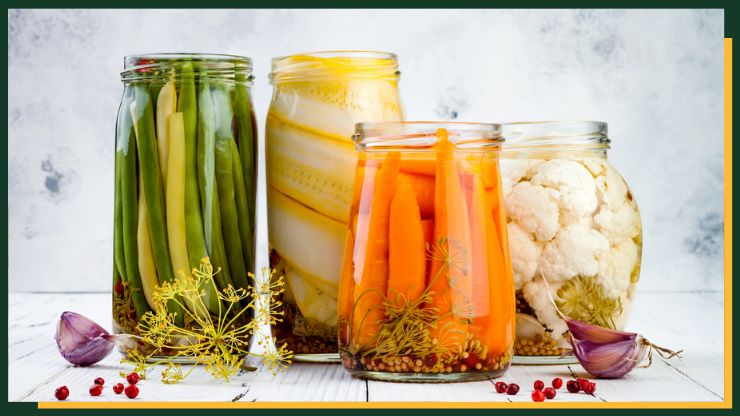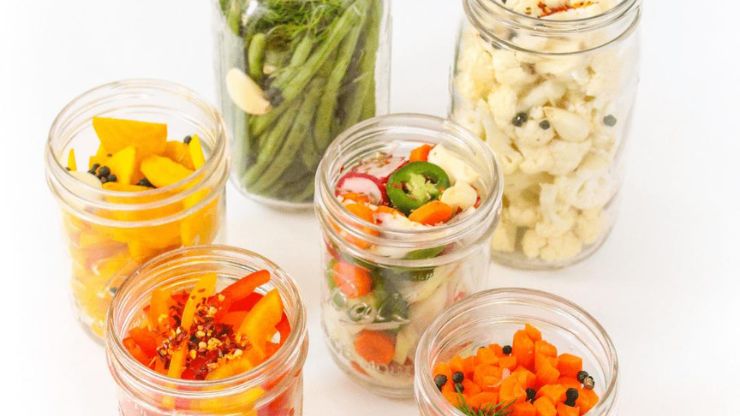Ferment Vegetables Without Using Mold – Fermenting vegetables is an ancient and practical method of preserving and enhancing their flavors and nutritional value. While the fermentation process offers numerous benefits, it’s crucial to ensure that mold doesn’t develop during this transformation. Mold not only affects the taste and safety of the final product but can also be a potential health risk.
In this guide, we’ll explore a series of proven tips to successfully ferment vegetables without mold. These tips encompass all stages of the fermentation process, from selecting the right vegetables to sealing and storing the final product.
By following these guidelines, you’ll be able to enjoy the delicious and healthful results of vegetable fermentation while avoiding the unwelcome presence of mold. Whether you’re a seasoned fermenter or just starting out, these tips will help you achieve consistently mold-free and tasty fermented vegetables.
Table of Contents
ToggleImportance of avoiding mold in the fermentation process
Avoiding mold in the fermentation process is of paramount importance for several key reasons:
- Safety: Mold can produce mycotoxins, which are harmful substances that can cause illness when consumed. Moldy vegetables can lead to food poisoning or other health issues, making it crucial to ensure the safety of fermented products.
- Quality: Mold development can significantly alter the taste, texture, and aroma of fermented vegetables, often resulting in an unpleasant and spoiled product. Maintaining mold-free fermentation preserves the intended flavors and quality of the vegetables.
- Preservation: The primary purpose of vegetable fermentation is to preserve the vegetables for an extended period. Mold can compromise the preservation process by accelerating spoilage, causing rot, and reducing the shelf life of the product.
- Consistency: Mold growth in one batch of fermented vegetables can potentially spread to other batches or contaminate fermentation equipment, leading to consistency issues and ongoing challenges with mold in future fermentations.
- Economic and Time Investment: Fermentation requires time and effort, as well as the cost of ingredients and equipment. Preventing mold ensures that your investment in terms of both time and resources is not wasted.
- Aesthetics: Mold-infested vegetables are unappealing to look at and may discourage people from consuming them. Mold-free fermentation results in visually appealing products that are more likely to be enjoyed.
- Sustainable Food Preservation: Fermentation is an eco-friendly and sustainable method of food preservation. Reducing the likelihood of mold contamination allows for the long-term storage of seasonal vegetables, minimizing food waste.
Also, Read – Best Fermented Foods
Ferment Vegetables Without Using Mold

Clean equipment
Thoroughly clean all equipment to prevent contamination in vegetable fermentation. Wash jars, lids, weights, and utensils with hot soapy water, rinse well, and let them air dry. Consider sanitizing with a food-grade sanitizer, like Star San.
Cleanliness is essential in maintaining a sterile environment to deter mold and unwanted bacteria. Additionally, ensure your hands are clean and avoid cross-contamination by using separate cutting boards and knives for raw and fermented foods. Proper sanitation decreases the risk of spoilage and promotes successful vegetable fermentation.
Fresh vegetables
Start with fresh, high-quality vegetables for successful fermentation. Choose produce that is free from mold, rot, or visible damage. Fresh vegetables not only taste better but also provide a clean slate for beneficial fermentation.
Wash them thoroughly to remove any dirt or residue, and consider using organic options when possible to reduce the exposure to pesticides.
Opt for in-season vegetables for optimal flavor and texture. Using fresh ingredients ensures a higher likelihood of a successful and delicious fermented vegetable outcome, as the initial quality of the vegetables directly impacts the final product.
Submerge the vegetables
It’s essential to keep the vegetables fully submerged in the brine during fermentation. This prevents mold growth and encourages the proliferation of beneficial bacteria. To achieve this, you can use a glass fermentation weight, a clean cabbage leaf, or even a zip-top bag filled with brine to weigh down the vegetables and keep them below the liquid surface.
Make sure there is minimal air contact with the vegetables to maintain an anaerobic environment. Check the submersion daily and make necessary adjustments to ensure that the vegetables stay below the brine level throughout the fermentation process. This practice promotes a successful and mold-free vegetable fermentation.
Use an airtight seal
Utilize an airtight seal when fermenting vegetables to create an anaerobic environment that discourages mold growth. Choose a suitable fermentation container, such as a glass jar with an airlock lid or a specialized fermentation crock with an airtight seal.
These containers help prevent the entry of oxygen, which can promote mold and unwanted microbial growth. Ensure that the seal is tight and properly closed to maintain a controlled environment within the vessel.
This airtight setup promotes successful vegetable fermentation by minimizing exposure to air and preserving the quality of your ferment while deterring mold formation.
Use a starter culture
In vegetable fermentation, adding a starter culture is beneficial for kickstarting the fermentation process and reducing the risk of mold. A starter culture introduces beneficial microorganisms that outcompete harmful ones.
You can use whey from yogurt, brine from a previous batch of fermented vegetables, or a commercial vegetable starter culture. Simply mix the starter culture with your brine or vegetables before packing them into the fermentation container.
This inoculation with friendly bacteria jumpstarts the fermentation, helping to establish a healthy microbial community and create a more controlled, mold-resistant environment. Using a starter culture can enhance the consistency and success of your vegetable fermentation while adding unique flavor profiles.
Don't just scroll, subscribe!
BuzzTrail's unique web-stories are the cure for boredom you've been waiting for.
Also, Read – Health Benefits of Fermented Foods
Control temperature
Maintaining a consistent temperature is crucial for successful vegetable fermentation. Most vegetable ferments thrive in a range of around 65-75°F (18-24°C). Fluctuations in temperature can affect the fermentation process and potentially lead to mold growth.
Ensure your fermentation vessel is placed in a location where the temperature remains relatively stable. Avoid extremes, as temperatures that are too cold can slow down fermentation, while those that are too hot can lead to over-fermentation and off-flavors.
Monitoring and regulating the temperature in this range will help promote a healthy and mold-free fermentation, allowing beneficial microorganisms to work optimally and preserve the vegetables.
Monitor and skim
Regular monitoring and skimming are essential during vegetable fermentation to prevent mold growth. Check your ferment daily, inspecting the surface for any signs of scum or mold.
Use a clean utensil or a spoon to skim off any unwanted growth promptly. Mold can develop on the surface, particularly when vegetables are exposed to air.
Skimming helps maintain a clean and healthy environment for fermentation by removing potential contaminants. Being vigilant and proactive in this practice ensures the success of your ferment and results in a mold-free, flavorful product.
Be patient
Patience is key in vegetable fermentation. Allow the process to unfold naturally over time, typically at least a week or longer, depending on your taste preferences. The flavors develop and become more complex as beneficial microorganisms work their magic.
Don’t rush the fermentation, as the duration is crucial for a balanced and tangy end product. While you might see some changes early on, the full depth of flavor and texture will require time.
Resist the temptation to open the container frequently, as this can disrupt the anaerobic environment and introduce potential contaminants. Trust the process, and your patience will be rewarded with a delicious, mold-free vegetable ferment.
Store properly
After your vegetable fermentation reaches the desired flavor, store it properly to maintain its quality. Transfer the fermented vegetables to the refrigerator, which slows down the fermentation process and preserves the flavors.
Use a clean, airtight container to store them, ensuring the lid is tightly sealed to prevent exposure to air. Make sure the vegetables are fully submerged in the brine. Proper storage in the refrigerator helps extend the shelf life and maintains the texture and flavor.
As time goes on, the flavors may continue to develop, so you can enjoy your fermented vegetables for several months, if not longer, while keeping them fresh and free from mold.
Use the right salt
Select the right salt for vegetable fermentation. Opt for non-iodized, high-quality salts like sea salt or kosher salt. These salts lack additives that may hinder fermentation. Aim for a salt concentration of about 1-2% by weight of the vegetables, which helps control microbial growth and preserve your vegetables.
Choosing the correct salt not only enhances the taste but also plays a crucial role in maintaining a successful and mold-free fermentation. High-quality salt contributes to the balance of flavors and supports the development of beneficial microbes while inhibiting mold and undesirable bacterial growth.
Conclusion
In conclusion, the success of fermenting vegetables without mold is vital to ensuring the safety, quality, and preservation of the final product. By following the proven tips outlined in this guide, you can enjoy the flavors and health benefits of fermented vegetables while sidestepping the pitfalls of mold.
Whether you’re an experienced fermenter or a novice, these strategies empower you to create consistently mold-free, delicious, and long-lasting fermented vegetables. Embrace the art of fermentation, savor the results, and share this knowledge to help others embark on their own mold-free culinary journey.
FAQs
Why is mold a concern in vegetable fermentation?
Why is mold a concern in vegetable fermentation?
Mold can be harmful to health and negatively impact the quality and safety of the fermented vegetables, affecting taste and texture.
How can I prevent mold from forming during vegetable fermentation?
How can I prevent mold from forming during vegetable fermentation?
The guide outlines several tips, including using clean equipment, quality salt and water, proper temperature, submerging vegetables, and maintaining hygiene.
What vegetables are suitable for fermentation?
What vegetables are suitable for fermentation?
Vegetables like cabbage, cucumbers, carrots, and radishes are commonly used, but various vegetables can be fermented successfully.

